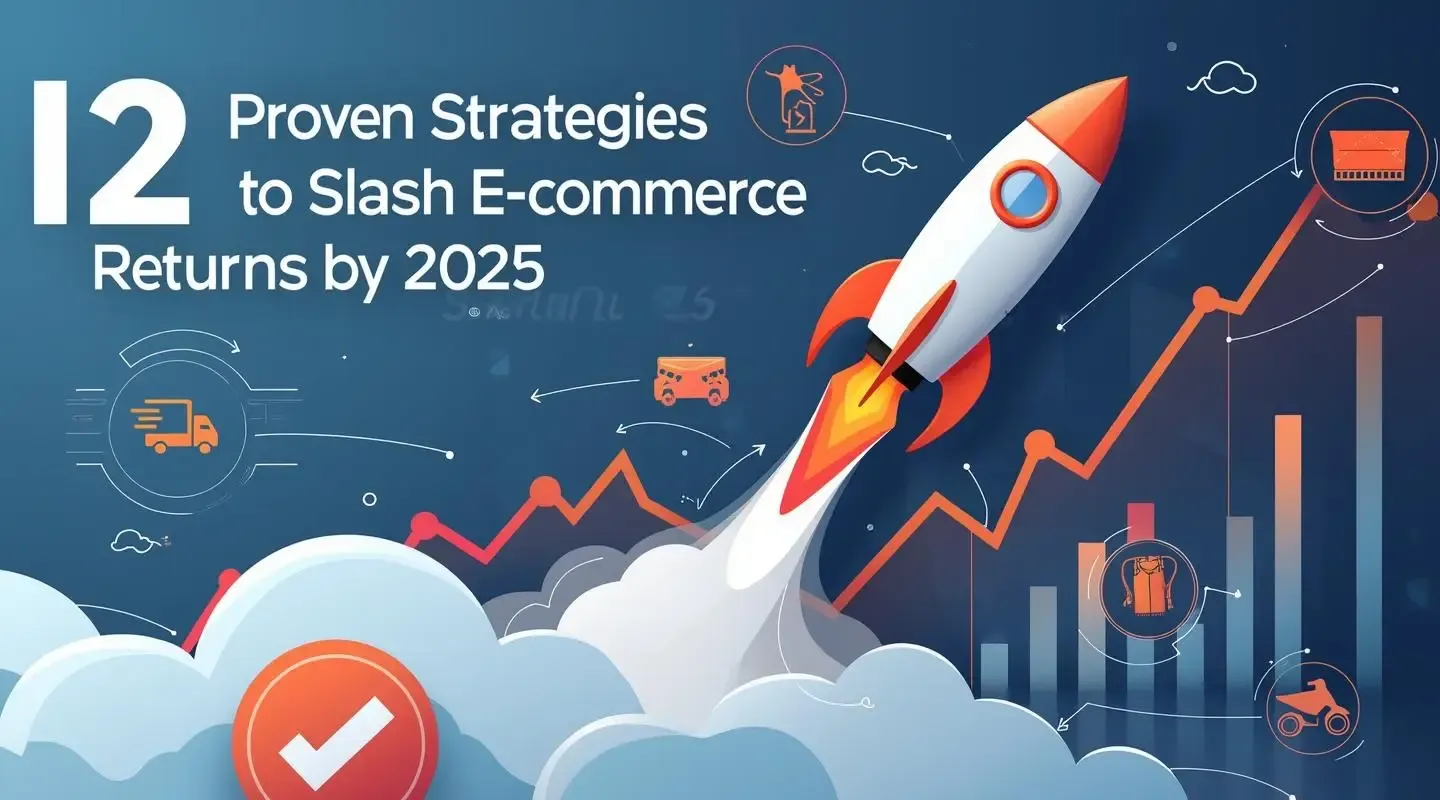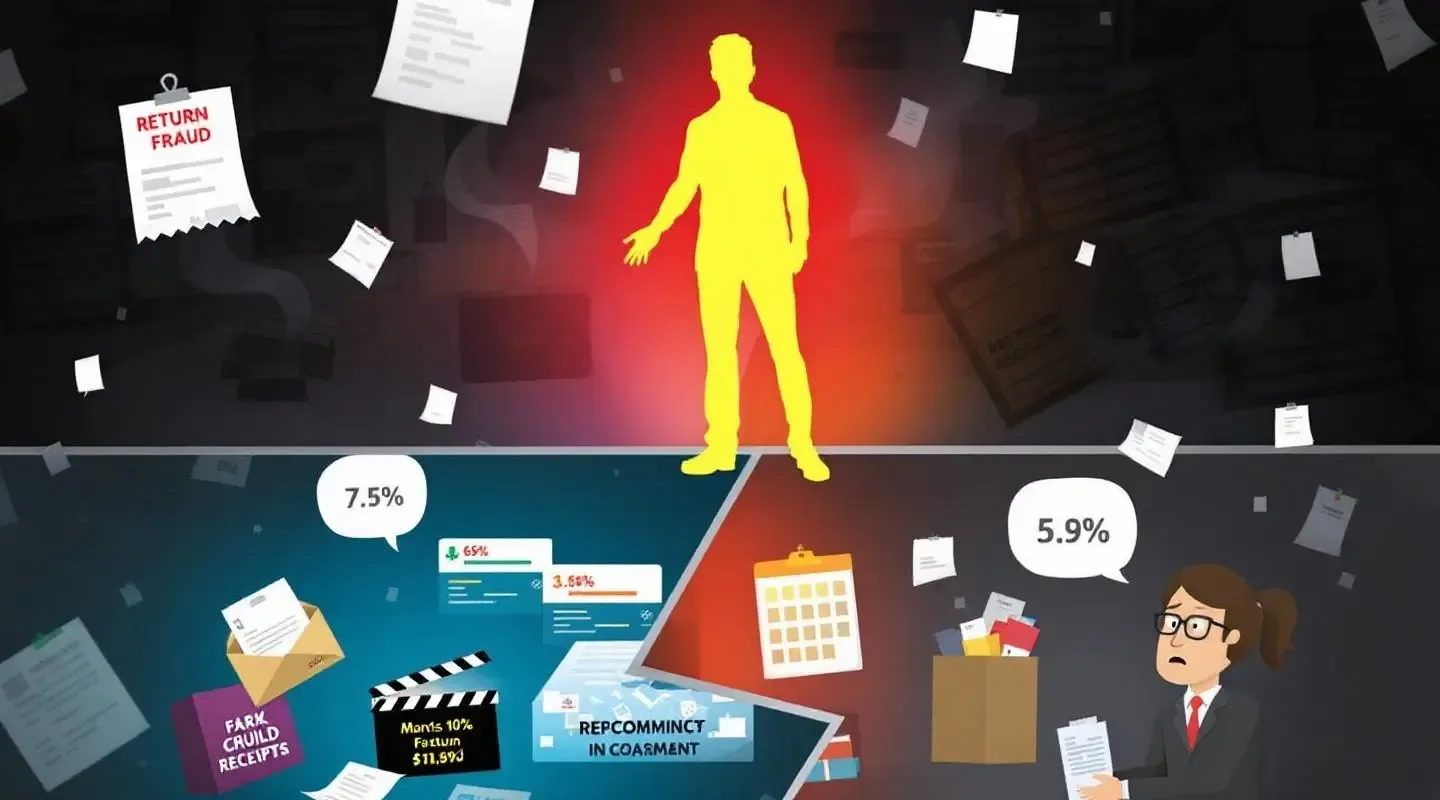Return rates are the silent profit killer that every eCommerce business faces, yet few address strategically. With the average eCommerce return rate reaching 16.9% in 2024—and climbing as high as 30% for some retailers—the cost of returns has become a critical business challenge that demands immediate attention.
But here's what most retailers don't realize: return rates aren't just a cost center to manage—they're a competitive advantage waiting to be unlocked. The businesses that master return reduction don't just save money; they create better customer experiences, improve operational efficiency, and build sustainable competitive moats.
This comprehensive guide reveals the 12 most effective strategies for reducing return rates, backed by real data, proven case studies, and actionable implementation frameworks. Whether you're dealing with sizing issues, product quality problems, or customer expectation mismatches, these strategies will help you transform returns from a business liability into a strategic advantage.
Understanding the Return Rate Crisis: The Numbers That Matter
Before diving into solutions, it's crucial to understand the scope and impact of the return rate challenge facing modern eCommerce businesses.
Industry Benchmarks: Where You Stand
Overall eCommerce Return Rates:
- Average return rate: 16.9% (2024 NRF data)
- Range: 15-30% depending on industry and product type
- Holiday season spike: Up to 40% increase during peak periods
- Growth trend: More than doubled since 2019 (from 8.1% to 16.9%)
Industry-Specific Benchmarks:
- Apparel & Fashion: 20-30% (highest due to fit issues)
- Electronics: 15-20% (complexity and compatibility issues)
- Home & Garden: 10-15% (size and quality expectations)
- Beauty & Personal Care: 8-12% (lowest due to consumable nature)
- Jewelry & Accessories: 12-18% (quality and style preferences)
Comparison to Physical Retail:
- Brick-and-mortar stores: ~8% average return rate
- eCommerce premium: 2-3x higher return rates than physical stores
- Primary driver: Inability to physically examine products before purchase
The True Cost of Returns
Understanding the financial impact of returns requires looking beyond the obvious refund amount:
Direct Costs per Return:
- Processing costs: $15-30 per return
- Shipping expenses: $8-25 for return shipping
- Inspection and restocking: $5-15 per item
- Customer service overhead: $3-10 per return inquiry
Hidden Costs (Often Overlooked):
- Inventory carrying costs: Products tied up in return processing
- Markdowns: Returned items sold at reduced prices
- Disposal costs: Items that cannot be resold
- Opportunity costs: Lost sales from out-of-stock situations
Total Cost Impact:
For every $100 in returned merchandise, businesses typically lose $150-200 when all costs are considered.
Case Study: Mid-Size Fashion Retailer
- Annual revenue: $50 million
- Return rate: 25%
- Direct return costs: $2.1 million annually
- Total impact including hidden costs: $3.2 million (6.4% of revenue)
Why Return Rates Are Increasing
Several factors are driving the upward trend in eCommerce return rates:
Consumer Behavior Changes:
- Bracketing: 50% of Gen Z buys multiple sizes/colors with intent to return
- Try-before-buy mentality: Returns viewed as part of the shopping process
- Social media influence: Purchasing for content creation, then returning
- Economic pressures: Using returns as temporary financing
Market Dynamics:
- Competitive pressure: Generous return policies as differentiation
- Customer expectations: Free returns now considered standard
- Mobile shopping growth: Higher return rates on mobile purchases
- International expansion: Cross-border returns complexity
Operational Challenges:
- Product information gaps: Insufficient online product details
- Quality control issues: Inconsistent product quality
- Fulfillment errors: Wrong items shipped to customers
- Packaging problems: Damage during shipping
Strategy #1: Master Product Information Architecture
The foundation of return reduction lies in providing customers with comprehensive, accurate product information that enables confident purchase decisions.
The Information Gap Problem
Primary Return Drivers:
- 65% of returns due to poor fit or sizing
- 56% due to products not matching descriptions
- 31% because items didn't meet expectations set online
The Cost of Information Gaps:
Poor product information doesn't just drive returns—it creates a cascade of problems:
- Higher customer service volume: 3x more inquiries for poorly described products
- Reduced conversion rates: 40% of shoppers abandon carts due to insufficient information
- Brand reputation damage: Negative reviews citing misleading descriptions
- Increased return processing costs: More complex returns requiring investigation
Comprehensive Product Description Framework
Essential Information Architecture:
- Primary Description: Clear, benefit-focused overview
- Technical Specifications: Detailed measurements, materials, features
- Use Cases: How and when to use the product
- Care Instructions: Maintenance and longevity information
- Compatibility Information: What works with this product
Fashion & Apparel Specifics:
- Fabric composition: Exact material percentages and properties
- Fit description: How the item fits relative to standard sizing
- Model information: Height, size worn, and styling context
- Care requirements: Washing, drying, and storage instructions
- Seasonal appropriateness: When and where to wear the item
Electronics & Technology:
- Compatibility matrices: What devices/systems work with the product
- Technical requirements: Minimum system requirements or specifications
- Setup complexity: Installation difficulty and time requirements
- Included accessories: What's in the box vs. what's sold separately
- Warranty information: Coverage details and claim processes
Advanced Sizing Solutions
Dynamic Sizing Charts:
Move beyond static size charts to interactive, personalized sizing:
Implementation Elements:
- Body measurement tools: Step-by-step measurement guides
- Size prediction algorithms: AI-powered size recommendations
- Fit feedback integration: Customer reviews about sizing accuracy
- Comparative sizing: How sizes compare to other brands
- Regional variations: Different sizing standards by geography
Case Study: Online Fashion Retailer
Implementation of advanced sizing solutions:
- AI-powered size recommendations based on customer measurements
- Fit prediction algorithm using purchase and return history
- Interactive size guide with video demonstrations
Results:
- 35% reduction in size-related returns
- 22% increase in customer confidence scores
- 18% improvement in conversion rates
- ROI of 340% within first year
Visual Information Optimization
Photography Standards:
- Multiple angles: Minimum 6-8 photos per product
- Lifestyle context: Products shown in use
- Detail shots: Close-ups of textures, features, and quality
- Scale references: Items shown with size indicators
- Color accuracy: Consistent lighting and color calibration
Video Content Integration:
- Product demonstrations: How the product works or fits
- 360-degree views: Complete visual inspection capability
- Unboxing videos: What customers receive and how it's packaged
- Styling videos: Multiple ways to use or wear the product
- Customer testimonials: Real users sharing experiences
Augmented Reality (AR) Implementation:
- Virtual try-on: See how products look on you or in your space
- Size visualization: Understand product dimensions in context
- Color matching: See how colors look in different lighting
- Placement tools: Visualize furniture or decor in your home
Strategy #2: Implement Intelligent Quality Control
Quality issues are responsible for 56% of returns, making quality control one of the highest-impact areas for return reduction.
Pre-Shipment Quality Assurance
Multi-Stage Inspection Process:
- Receiving inspection: Check products upon warehouse arrival
- Storage quality control: Monitor condition during warehousing
- Pick verification: Confirm correct items are selected
- Pre-pack inspection: Final quality check before packaging
- Post-pack verification: Ensure proper packaging and labeling
Technology-Enhanced Quality Control:
- Computer vision systems: Automated defect detection
- Barcode verification: Ensure correct products are shipped
- Weight verification: Catch missing items or incorrect quantities
- Photo documentation: Visual records of product condition
Quality Control Metrics:
- Defect detection rate: Percentage of quality issues caught pre-shipment
- False positive rate: Incorrectly flagged products
- Processing time impact: Quality control effect on fulfillment speed
- Cost per inspection: Resource investment vs. return prevention
Supplier Quality Management
Vendor Quality Standards:
- Incoming quality requirements: Specifications for acceptable products
- Quality testing protocols: Regular sampling and testing procedures
- Defect rate tracking: Monitor supplier performance over time
- Corrective action processes: Address quality issues systematically
Supplier Scorecards:
Track key quality metrics for each supplier:
- Defect rates: Percentage of products with quality issues
- Return rates: Customer returns attributed to supplier quality
- Compliance scores: Adherence to quality standards
- Improvement trends: Quality performance over time
Case Study: Electronics Retailer
Comprehensive supplier quality management program:
- Incoming inspection protocols for all electronic components
- Supplier quality scorecards with monthly reviews
- Quality-based supplier ranking system
- Corrective action requirements for underperforming suppliers
Results:
- 68% reduction in quality-related returns
- $1.8 million annual savings in return processing costs
- 45% improvement in customer satisfaction scores
- 25% reduction in supplier base through quality-focused consolidation
Packaging and Shipping Protection
Protective Packaging Design:
- Product-specific packaging: Tailored protection for different product types
- Damage prevention: Cushioning and protection materials
- Tamper evidence: Security features to prevent theft or switching
- Unboxing experience: Packaging that enhances customer satisfaction
Shipping Partner Quality:
- Carrier performance tracking: Monitor damage rates by shipping provider
- Route optimization: Choose shipping methods that minimize handling
- Insurance and claims: Protect against shipping-related damage
- Customer communication: Proactive updates about shipping status
Implementation Roadmap: Your 90-Day Action Plan
Implementing comprehensive return reduction strategies requires a systematic approach. Here's a practical 90-day roadmap to get started:
Days 1-30: Foundation and Assessment
Week 1: Data Collection and Analysis
- Audit current return rates by product category, customer segment, and time period
- Analyze return reasons and identify top 3 drivers of returns
- Benchmark performance against industry standards
- Assess current return processing costs and hidden expenses
Week 2: Technology and Process Audit
- Evaluate current product information quality and completeness
- Assess fulfillment accuracy and quality control processes
- Review return policy effectiveness and customer feedback
- Identify technology gaps and improvement opportunities
Week 3: Customer Research
- Survey recent customers about return experiences and reasons
- Analyze customer service inquiries related to returns
- Review customer feedback and reviews for return-related insights
- Identify customer pain points in the purchase and return process
Week 4: Strategy Development
- Prioritize return reduction strategies based on impact and feasibility
- Develop implementation timeline and resource requirements
- Establish success metrics and measurement frameworks
- Create cross-functional team and assign responsibilities
Days 31-60: Quick Wins and Foundation Building
Week 5-6: Product Information Enhancement
- Improve product descriptions and specifications for top-returned items
- Add missing sizing information and measurement guides
- Enhance product photography with multiple angles and detail shots
- Implement customer review integration for social proof
Week 7-8: Quality Control Implementation
- Establish pre-shipment quality control checkpoints
- Implement barcode verification and weight checking systems
- Create quality control metrics and tracking systems
- Train fulfillment team on new quality procedures
Days 61-90: Advanced Strategy Implementation
Week 9-10: Technology Integration
- Implement AI-powered size recommendation system
- Deploy return prediction analytics for high-risk orders
- Launch virtual try-on or AR visualization tools
- Integrate advanced customer support and chat systems
Week 11-12: Policy and Process Optimization
- Launch exchange-first return policy initiatives
- Implement customer education and onboarding programs
- Deploy retention incentive programs for at-risk returns
- Establish continuous improvement and optimization processes
Ongoing: Measurement and Optimization
Monthly Reviews:
- Analyze return rate trends and identify emerging patterns
- Review strategy effectiveness and adjust tactics as needed
- Optimize processes based on performance data and customer feedback
- Plan next phase of return reduction initiatives
Quarterly Assessments:
- Comprehensive review of return reduction program performance
- ROI analysis and business impact assessment
- Strategic planning for next quarter's initiatives
- Technology and partnership evaluation and optimization
Conclusion: The Strategic Advantage of Return Mastery
Reducing return rates isn't just about cutting costs—it's about creating a sustainable competitive advantage that touches every aspect of your business. The companies that master return reduction don't just save money; they build stronger customer relationships, improve operational efficiency, and create more predictable, profitable businesses.
The Compound Benefits:
Financial Impact:
- Direct cost savings: Reduced return processing and shipping costs
- Revenue protection: Higher percentage of sales retained
- Operational efficiency: Streamlined processes and reduced complexity
- Profit margin improvement: Better unit economics across all products
Customer Experience Enhancement:
- Higher satisfaction: Customers receive products that meet expectations
- Increased confidence: Better product information and support
- Stronger loyalty: Positive experiences drive repeat purchases
- Brand differentiation: Superior experience compared to competitors
Operational Excellence:
- Improved forecasting: More predictable demand and inventory needs
- Quality improvements: Better products and processes
- Team efficiency: Resources focused on growth rather than problem-solving
- Scalability: Systems that support growth without proportional cost increases
The Strategic Imperative:
Return reduction is not optional in today's competitive eCommerce landscape. The businesses that invest in comprehensive return reduction strategies today will have significant advantages over those that treat returns as an unavoidable cost of doing business.
Start with the strategies that offer the highest impact for your specific situation, but don't stop there. The most successful return reduction programs are comprehensive, systematic, and continuously optimized based on data and customer feedback.
Your Next Steps:
- Assess your current situation using the frameworks provided in this guide
- Prioritize strategies based on your specific return drivers and business constraints
- Implement systematically using the 90-day roadmap as your starting point
- Measure relentlessly and optimize based on performance data
- Scale successful initiatives across your entire product catalog and customer base
The investment you make in return reduction today will pay dividends for years to come through improved profitability, customer satisfaction, and competitive positioning. The question isn't whether you can afford to invest in return reduction—it's whether you can afford not to.




